Data and Travel Tips
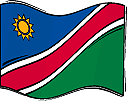 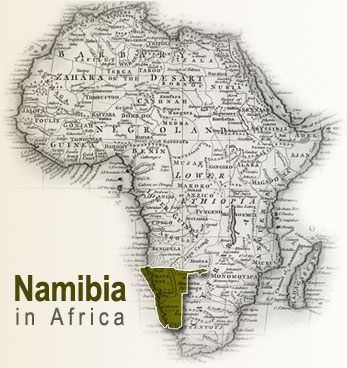
Info on Namibia
 Namibia with its 824.292 km² is approximately twice the size of the Federal Republic of Germany and only has about 2 million inhabitants i.e. 2,2 inhabitants per km². It is thus one of least densely populated countries in the world. Namibia with its 824.292 km² is approximately twice the size of the Federal Republic of Germany and only has about 2 million inhabitants i.e. 2,2 inhabitants per km². It is thus one of least densely populated countries in the world.
 Windhoek, Namibia’s capital, has approximately 250.000 inhabitants. Windhoek, Namibia’s capital, has approximately 250.000 inhabitants.
 Although the Namibian government rejects a differentiation of Namibians into ethnic groups and even though ethnological and language features are often closely related, it is still of significant relevance which population group a person belongs to. Apart from English, the official language, at least 28 other languages are spoken. Although the Namibian government rejects a differentiation of Namibians into ethnic groups and even though ethnological and language features are often closely related, it is still of significant relevance which population group a person belongs to. Apart from English, the official language, at least 28 other languages are spoken.
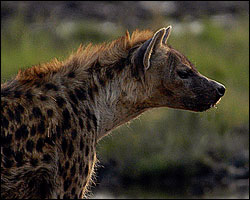  The Namib and Kalahari Deserts cover a large part of the country. Semi-deserts and dry savannah determine the landscape of the rest of Namibia. However, in the extreme north, it is green and fertile. The Namib and Kalahari Deserts cover a large part of the country. Semi-deserts and dry savannah determine the landscape of the rest of Namibia. However, in the extreme north, it is green and fertile.
From the oldest desert in the world in the south to the swamps and tropical Okavango in the north, this country offers constantly changing backdrops and a diversity of abundant wildlife. Life in Namibia is one premiere after another.
 Namibia’s rich wildlife is unique in Africa. Cheetah, lion, elephant, leopard and rhino can be seen outside of national parks. One often sees various species of antelope on the road verges. Zebras, ostriches and warthogs cross the roads, while baboons scratch their backs on the top of telephone poles. Namibia’s rich wildlife is unique in Africa. Cheetah, lion, elephant, leopard and rhino can be seen outside of national parks. One often sees various species of antelope on the road verges. Zebras, ostriches and warthogs cross the roads, while baboons scratch their backs on the top of telephone poles.
 Namibia’s currency is the Namibia Dollar (N$). It is divided into 100 Cents. The following bank notes are available: 200,100,50,20,10 N$ and coins of N$5, N$1 and 50, 10 and 5 cents are in circulation. The N$ has the same value as the South African Rand (ZAR). The South African Rand is also accepted throughout the country as legal tender. Traveller’s Cheques are also widely accepted. Namibia’s currency is the Namibia Dollar (N$). It is divided into 100 Cents. The following bank notes are available: 200,100,50,20,10 N$ and coins of N$5, N$1 and 50, 10 and 5 cents are in circulation. The N$ has the same value as the South African Rand (ZAR). The South African Rand is also accepted throughout the country as legal tender. Traveller’s Cheques are also widely accepted.

Climate
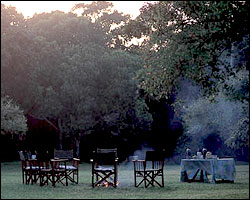  Namibia is an ideal year round destination. September to April temperatures can rise to 38° Celsius and from May until August range between 18 - 25° Celsius – occasionally at night and early morning below freezing point. Rain mainly falls between January and March. Namibia is an ideal year round destination. September to April temperatures can rise to 38° Celsius and from May until August range between 18 - 25° Celsius – occasionally at night and early morning below freezing point. Rain mainly falls between January and March.
 The most comfortable time of year for travel is our dry season (April – End of October). The winter months (May – September) are characterised by warm days (18 - 25° C) and cold to very cold nights (June/July down to freezing point). By the middle of September the days get noticeably warmer with fewer cold nights. October can be very hot. The most comfortable time of year for travel is our dry season (April – End of October). The winter months (May – September) are characterised by warm days (18 - 25° C) and cold to very cold nights (June/July down to freezing point). By the middle of September the days get noticeably warmer with fewer cold nights. October can be very hot.

Travel Tips and Info
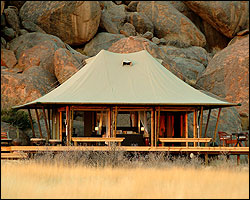  Travel Insurance: Travel Insurance:
It is always recommended to obtain adequate cancellation insurance. If you cancel your safari less than four weeks prior to the start of your trip you could lose unnecessary money.
 Luggage: Luggage:
Most airlines limit passengers to 12-20 kilograms. On safari your luggage should be in soft bags and not in hard shell suitcases. Should you be flying in small aircraft within the country, soft bags are a must as they are easily stowed.
 Health: Health:
Please ensure that you have adequate foreign medical insurance before you start your trip. This can be obtained at short notice online through ADAC (whether one is a member or not).
 Inoculations: Inoculations:
Recommended are the following: Tetanus, Diphtheria, Polio and Hepatitis A. The northern part of the country, including the Etosha National Park and the Caprivi, is a malaria risk area throughout the year. We thus recommend that you take some form of malaria prophylaxis. Windhoek southwards is a malaria free area.
Not every tour enters malaria risk areas, however, if you prefer to be sure, then take a malaria prophylaxis. We recommend that you contact your nearest tropical diseases institute who can provide you with information. Detailed information can also be obtained from the independent advisory service for tourists with regard to health risk in foreign countries. The contact details of the “Reisemedizinischen Zentrums“ (Travel Medical Centre) are Tel. 0900 / 1234-999 (1,80 Euro per minute) or at www.gesundes-reisen.de
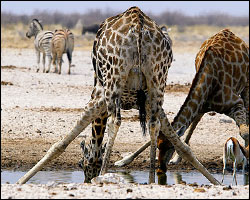  Water: Water:
The water here has been tested and is far cleaner than in many parts of the world. It is drinkable. The reason why there are many different brands of bottled water is because the taste varies according to the mineral content in different substrates.
 Entry Formalities: Entry Formalities:
A prerequisite is a passport that is still valid for six months after your intended departure date. German, Austrian and Swiss passport holders do not require visas. Please ensure that you have at least 2 blank pages in your passport for entry stamps.

Checklist : |
 Passport, air ticket, money Passport, air ticket, money
 Neutral safari clothes (we are not in a war zone – please do not bring military or camouflage items). All lodges provide a laundry service Neutral safari clothes (we are not in a war zone – please do not bring military or camouflage items). All lodges provide a laundry service
 Hat Hat
 Closed shoes Closed shoes
 Citronella or Autan insect repellent Citronella or Autan insect repellent
 A warm fleece jacket or pullover A warm fleece jacket or pullover
 Long trousers – mornings in the desert can be quite chilly Long trousers – mornings in the desert can be quite chilly
 Enough film and batteries for the cameras Enough film and batteries for the cameras
 Photographically, Namibia has a lot to offer. Imagine endless vast landscapes. If you have, tele-lenses of 500 mm or more are recommended for unforgettable shots – the bigger the lens the better! Photographically, Namibia has a lot to offer. Imagine endless vast landscapes. If you have, tele-lenses of 500 mm or more are recommended for unforgettable shots – the bigger the lens the better!
 Binoculars Binoculars
 Sunglasses, high factor sunblock and After Sun Lotion Sunglasses, high factor sunblock and After Sun Lotion
 Bathing costumes Bathing costumes
 Medicine of a personal nature Medicine of a personal nature
 A torch is recommended A torch is recommended |
|



